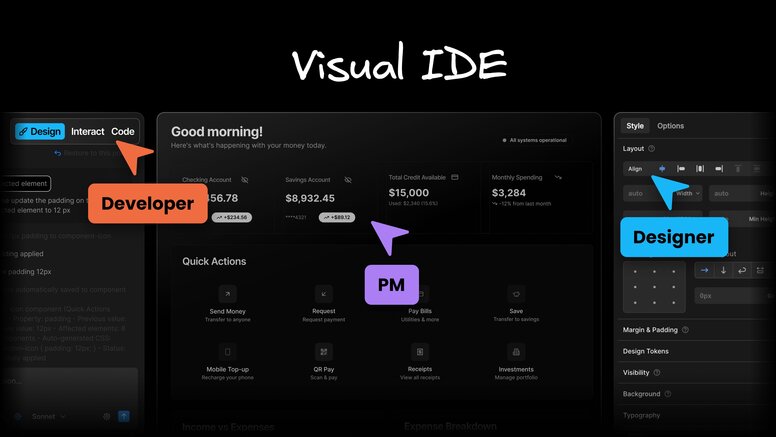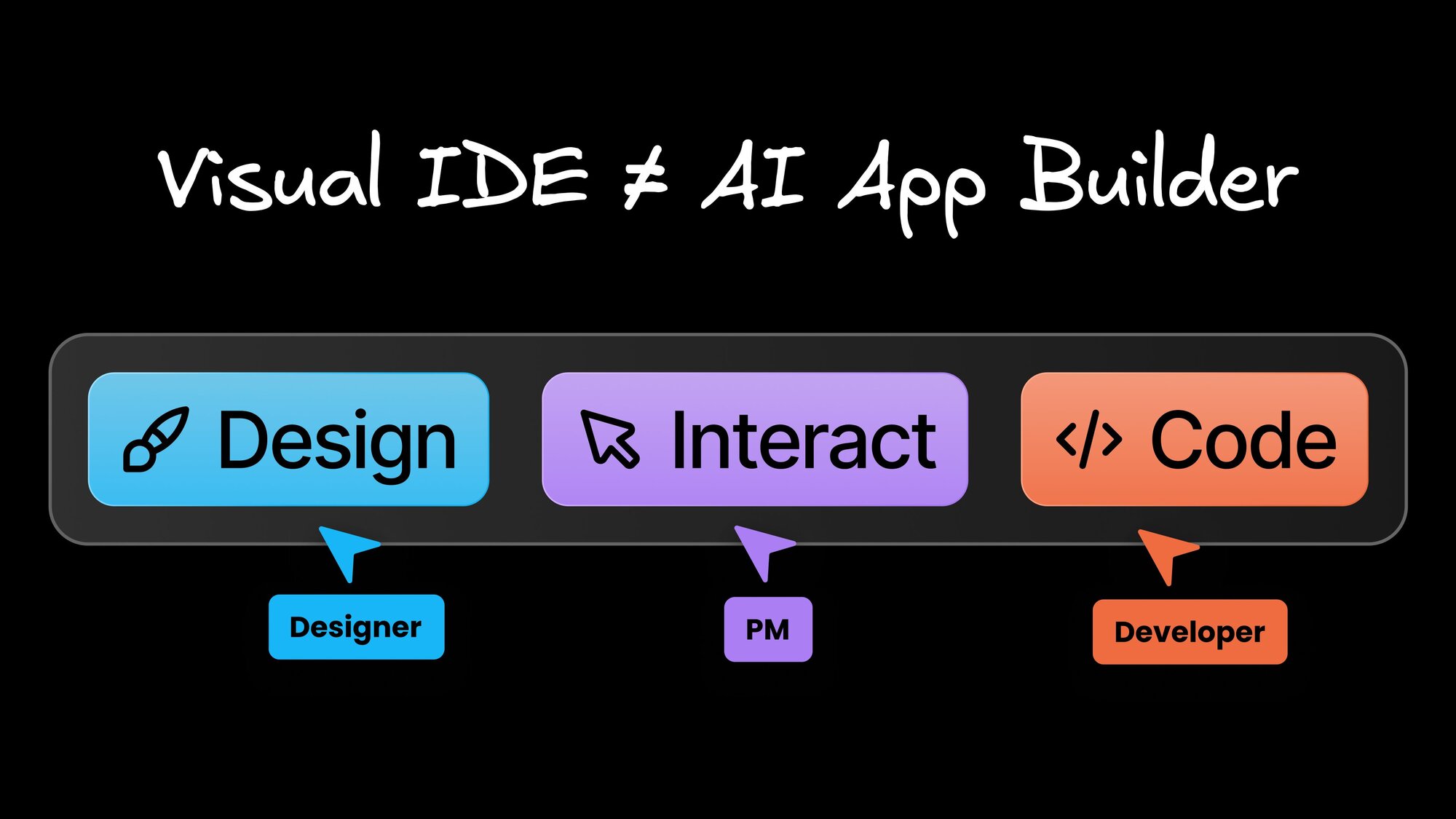"Look what I built with AI! Can we add this to our product now?". A dreaded sentence by engineers, who have to explain for the nteenth time that AI app builders don't give them code that is actually usable.
The thing is, there are already AI tools that give usable code to developers every day—regardless of the complexity of a project. They are AI IDEs. They connect to anything and let anyone edit with natural language. So why don't the AI app builders work like this?
The short answer is—they are a different thing. Let's break down the confusion between an AI app builder, an AI IDE, and a new contender, the Visual IDE.
It is not hard to see why the mix-up happens. AI app builders feel magical. With a few prompts, pretty much anyone can generate an app running in a browser, complete with hosting and a database. For someone who has never touched code, it feels like skipping straight to the finish line. That demo effect is powerful enough that buyers and even teams start to assume that Visual IDEs are just a more advanced version of the same trick.
The reality is different. The same qualities that make app builders look great in the moment (speed, simplicity, one-click deployment) are the same ones that make them fall apart when you try to build anything that lasts.
App builders are best thought of as tools for individuals, not teams. They are fine for a founder who wants to test an idea over the weekend or for a small business that just needs a basic site. But when you try to use them inside a real product team, the limits show up fast. The stack is locked down. The generated code is brittle. There is no way to line it up with your design system or your compliance requirements.
At the end of the day, app builders are like Wix or Squarespace. Great for spinning something up fast, fine for hobby projects, but not something you can run a product team on. I've never seen one hold up in production once a real team tried to use it.

A Visual IDE is built for teams. It has the same underlying power as an IDE like VS Code, but it makes that power accessible enough that product managers and designers can contribute directly. Instead of creating something in a sandbox, a Visual IDE works in your actual repo. You create a branch, make visual edits, and open a pull request.
The point is that it cuts out the handoff. Passing requirements from design to engineering is like passing a melting ice cube: every stage loses something.
In a Visual IDE, everyone works in code from the start. Designers can explore ideas in working prototypes. PMs can test and collect feedback in the same system the product will ship. Engineers inherit working code instead of static files. Designers, PMs, and engineers all stay connected in one workflow.
I've even watched non-developers ship production features in a Visual IDE. That just does not happen with app builders.
Visual IDEs are not for everything. Heavy backend systems or deep infrastructure work are not the focus. But for front-end flows, prototyping, and iterative product work, they are transformative.
The real test of a tool is what happens after the demo. An app builder can make something look great, and even seems to work, but once you try to scale that work across a real team, the cracks show. The code doesn't match your design system. The stack is locked down. Engineering quietly sets it aside.
A Visual IDE keeps going where app builders fall apart, because it was built for teams from the start. Designers don't lose quality when their work hits code. PMs can try ideas in the same system the product will eventually ship. Engineers inherit something that fits their workflows instead of a throwaway mock-up.
And the gap isn't small. Most AI tools aimed at developers give you no better than a 20% speed-up. A Visual IDE changes the workflow itself. It takes whole steps out, closes feedback loops faster, and shifts energy away from rework into actual building.
That kind of shift is what makes the difference between a demo that gets applause and a product that scales.
At enterprise scale, the cracks show up fast. Product leaders feel roadmap risk when features miss market windows and competitors move faster. Design leaders see brand trust erode when quality breaks down across teams and regions. Engineering leaders face technical debt compounding across a sprawling codebase, with rework slowing every release.
A Visual IDE doesn't just save cycles. It preserves design intent, shifts testing earlier, and gives engineers code they can scale. The result is fewer misses against the goals leaders are accountable for, and a workflow that holds up under enterprise complexity.
A Visual IDE keeps design intent intact, moves testing earlier, and gives engineering working code instead of static files. The result is not just faster cycles, but fewer misses against the goals leaders are accountable for.
App builders aren't useless. They're a phase. Many teams start with them, but the ceiling shows up fast.
For product leaders, that ceiling looks like missed roadmap goals and losing out to faster competitors. For design leaders, it looks like customer complaints about inconsistent UX and trust falling away when designs never match what ships. For engineering leaders, it looks like technical debt piling up and teams stuck in QA instead of building new features.
Those are not small problems. They are signs the tool has hit its limit. Once you care about scale, governance, or customer trust, you outgrow app builders.
App builders are fine for quick tests and demos. But they do not scale.
A Visual IDE is not just a faster app builder. It is a different category entirely. It plugs into your repo, respects your workflows, and lets the whole team ship without throwing work away. That is the difference between a project that looks slick and a product that still works months later.
That is what makes it a no handoff way of working, and why teams feel the difference the moment they switch.
If you want to see what this looks like in practice, The No Handoff Methodology shows how design leaders are moving past handoff waste, How fast teams stay fast at scale breaks down how velocity and quality can coexist, and How to evaluate vibe coding tools offers a framework for knowing which approaches will actually work in production.
If your team has outgrown prototypes and is ready to build in production from the start, it is time to try Fusion.
Builder.io visually edits code, uses your design system, and sends pull requests.
Builder.io visually edits code, uses your design system, and sends pull requests.




 Connect a Repo
Connect a Repo








